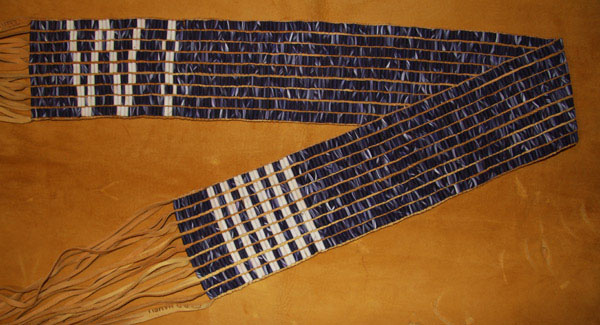 |
Photographs (left to right): Mt. Charleston, Nevada; Tetons, Wyoming; Snapper, Mendon Ponds Park, New York
Wampum Belt Archive
William Johnson - Niagara Siege Wampum Belt

Reproduction: R. D. Hamell
April 12 2011
Original Size: |
? |
Reproduction: |
Beaded length: 39.25 inches. Width 4.1 Length w/fringe: 63.25 inches. |
Beads: |
Rows: 245 by 9 beads wide. Total 2,205. |
Materials: |
Warp: Leather. Weave: artificial sinew. |
Description:
Beauchamp described this belt (p. 391) when Johnson held a council in preparation of the siege of Fort Niagara in 1759. The Six Nations presented Johnson with "a Belt with the Figure of Niagara at the end of it, & Sir William's name worked thereon." Another report described the falls as illustrated by a several parallel lines. However, the number of lines, how Johnson's name was portrayed and the background color of the belt was not included. It was my decision to make it a purple-fielded belt, representing war and use the initials G.I. for Johnson as other belts have been done. The I initial is the old English J. Also I arbitrary used 6 parallel lines representing the falls. The length and width of the belt is also arbitrary. This design was inspired by Becker and Lainey's (2004) inference of what the 'Falls" image could have been:
" The William Johnson Belt of 1759.
In his section on lettered belts Beauchamp refers to "one other belt [that] must have been inspired for the [special] occasion. Preparations for the siege of Fort Niagara were in progress and Johnson held a council. At this [council] the Six Nations presented him [with] 'a Belt with the Figure of Niagara at the end of it, & Sir William's name worked thereon.'" Probably only initials were worked into a design on this belt. The "Figure of Niagara" may refer to an end design such as that commonly found on belts,
taking the form of a series of parallel lines. A design such as that could be interpreted as representing the famous falls or even a human namesake. The possibility that this belt and the WJ 1756 belt are one and the same must be considered (Becker and Lainey, 2004).
Another reference to this belt was by Timothy Shannon:
"With the fall of Louisbourg, Frontenac, and Duquesne, the pendulum had swung decisively in Britain's faveor, and for the Iroquois, that meant it was time for neutrality to give way to alliance. In April 1759, Johnson convened a treaty conference with the Six Nations and several affiliated tribes at Canajoharie. Invoking the Treaty of Easton completed a few months earlier, he hand-delivered to an Onondaga chief the 'Instrument of Release and Surrender' for the 'Lands on the Ohio' that the Penn family had purchased at the Albany Congress. He then threw down a war belt and asked for warriors to join the British in the coming campaign season. a delegation of Senecas accepted the war belt, signaling that the western Iroquois were ready to support the British, and they pressed Johnson to attack the French at Niagara. Johns hosted a grand feast and distributed presents the following day. The Indians reciprocated with a wampum belt 'with the Figure of Niagara at one end of it, and Sir William's name worked thereon (Campbell)."
Reference:
Becker, Marshall J. and Jonathan Lainey. 2004. Wampum Belts with Initials and/or Dates as Design Elements: A Preliminary Review of One Subcategory of Political Belts. American Indian Culture and Research Journal, Vol. 28, No. 2, pp. 25-45.
Beauchamp, William M. 1901. Wampum and Shell Articles Used By The New York Indians. NYS Museum Bulletin No, 41, Vol. 8, 429pp.
Campbell, Patrick (ed.). Travels in the Interior Inhabited parts of North America in the Years 1791 and 1792. H.H. Langton, Toronto. The Champlain Society.
Shannon, Timothy J. 2009. Iroquois Diplomacy on the Early America Frontier. Penguin Library. 260 pp.
 |
 |
 |
 |
 |
 |
 |
 |
|---|
